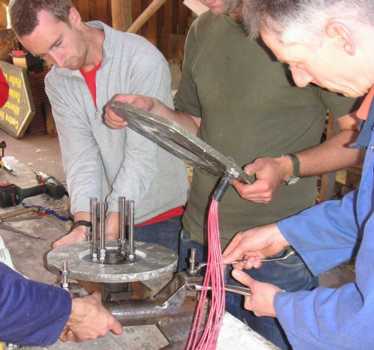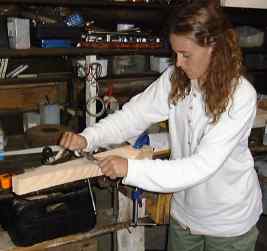Home-Built Windpower
updated January 2007
[email protected]
This page is designed to help those who plan to build their
own wind turbine. I hope you find it useful.
Some of it is getting
a bit dated - especially the stuff about brakedrums.
I am teaching workshop
courses in wind generator construction, here in Scotland
and also in the USA and Wales.
See my courses
pages for many stories and pictures of homebrew windpower.
Details of how to buy my books
on home built wind turbines
Links to other good sites for home
made windpower:-
http://www.otherpower.com
Windstuffnow
Chuck
Morrison's site
Andy
Little's site
Dave
Allender
Windmill plans and courses
from Peru
eco-inn
windpower course in New Zealand
Otherpower's
discussion board is full of fast moving action on the
windmill
building front with pictures.
What size of wind turbine do I need, and what can it give me?
Before you do anything else, you have to know how much power
your
windturbine is likely to produce and make sure that the speed of the
rotor
blades matches the speed of the alternator (or whatever produces the
electricity).
If you fail, and the alternator is too fast or the rotor too slow, for
example, then you will not produce any power.
I am going to use some rough scans of a few tables from my
book
Windpower
Workshop chapter 1, which will help you with the overall
design of your wind machine. I am using scans because the
original
files went in the sea with my computer back in '97.
The first table tells you how much power
you can expect from a wind machine, when you know how big it is,
and how strong the wind is.

Readers in the USA should note that one metre diameter is about 3 feet,
and 3 metres is ten feet.
Clearly, size matters, but windspeed matters even more.
And above all do not forget SAFETY, which must be a paramount
concern.
There is a whole chapter on the subject in the book.
Wind turbines are usually designed to work best in the range 3 -
12m/s,
but windspeeds as high as 12m/s are not common (everyday) occurrences,
so don't expect to get such high power outputs often enough to be
relied
on. It is usually a good idea to avoid very high power (high
wind)
operation altogether, unless you plan to use the machine for heating
purposes
on rare occasions. To avoid damage in high winds, you will need a
good control system which reliably protects the machine from the wind's
fury.
In terms of what you can run from the
wind
system, the average power is more useful information. From this
average
you can then work out how many Amphours of battery charge per average
day
you might get.

4.5m/s or ten mph is a typical average windspeed, for an open site
with
few obstructions.
A 2 metre diameter machine would probably give about 50 watts average
output
(although it might produce 200 watts or more at times).
An average output of 50 watts may not sound much, but over a 24 hour
period you can expect
50W/12V x 24h = 100 Amp-hours of charge (on average) into a 12
volt battery.
This is sufficient to run five 'energy efficient' lamps, each using
2 amps, for ten hours.
In reality, some of the energy will be lost in the process of charging
and discharging the battery,
but you get the general idea, I hope.
Once you have chosen the size of wind turbine, you need to design
the
blades and find or build a generator or alternator to match them.
Blade design
To design the blades, may find it useful to study some notes I
have put on the web at another site:-
a short course in blade design I
prepared for the Centre for Alternative Technology.

Your main decision will be choosing the tip speed ratio of
your
rotor blades.
The 'tip speed ratio' is how much faster, than the windspeed, the blade
tips travel.
High tip speed ratio means more speed, low tip speed ratio needs more
blades.
On the whole, high tip speed ratio is better, but not to the point
where the machine becomes noisy and highly stressed. This next
diagram
show four rotors, designed to run at different tip speed ratios.

The tip speed ratio will determine how fast your wind turbine will
want
to turn, and so it has implications for the alternator you can use.
Here are some on-line guides to the detail of how I make blades:
- Chuck Morrison
has
produced a set of templates for carving blades according to my books.
There is also a guide to fibreglass blade manufacture on my download
page
I edited the document but I did not write it - I do not have experience
with making fibreglass blades myself.

Following through our example of the 2 metre (six foot is 1.8m)
diameter
machine, and choosing a tip speed ratio around 6 we find that the
machine
will run at about 600rpm. This leads to the biggest problem in
home-built
windpower. You will not find an alternator or generator which
will
give your required power (250 watts) while running at that speed. So
you
will either have to use gearing to change the speed, or build or adapt
a special machine. The second option is the better of the two.
Finding a suitable alternator....
Check at Windmission
where you may be able to buy a purpose built permanent magnet
alternator
(PMG).
Or again you can use a permanent-magnet
"servo"
motor from a surplus store in the USA
or a 'Smart drive' washing machine motor from new zealand (see ecoinn )
)
or try a czech alternator at http://mgplast.web.worldonline.cz/
Alternator design
I recommend the Axial
flux alternator plans (June 2005) because they contain my latest
ideas.

The photo shows an alternator being assembled. The first
magnet rotor is already mounted, and the stator is being fitted.
Later a second rotor will be mounted on the four studs so that the
stator is sandwiched. The magnets in both rotors, and the stator
coils, are set in polyester resin castings. The process is easy,
and requires no special tools or skills.
More help for homebuilders at www.otherpower.com
wind alternators
Check out the www.fieldlines.com postings for
otherpower Monday sessions like this
try Windstuffnow
for an alternator recipe
A book "the homebuilt dynamo" by New
Zealand
author Alfred T. Forbes is available from Graham Chiu
(around $US60)
It explains
in great detail how to build your own permanent magnet
alternator.
This is one fat glossy book.
Help with finding magnets for building
your
own alternator here.
Finally, (last but not least!) here is a link to a free
public domain on-line alternator construction manual in pdf format
(2001).
I developed this design as an aid project for Intermediate Technology
Development Group (ITDG) with funding from the UK government.

Click on the image above to contact Phil.
Other Aspects of the design
Control is very important. Your wind turbine needs
controls
to prevent it from overspeeding in gales. I use a furling tail
arrangement.
Later I shall post an explanation for this but meanwhile you will have
to buy one of my books.
Windpower workshop does not go into the details of
construction
quite so deeply for any single machine, but it covers a lot of ground,
including towers and how to erect them.

For
details of how
to buy my books please follow this link.
[email protected]
Hugh Piggott
- back to my home page..






